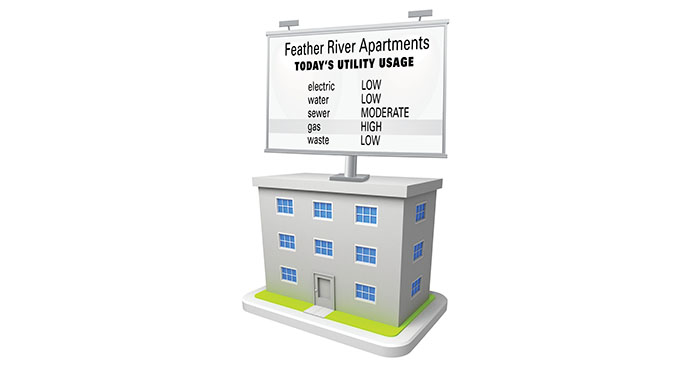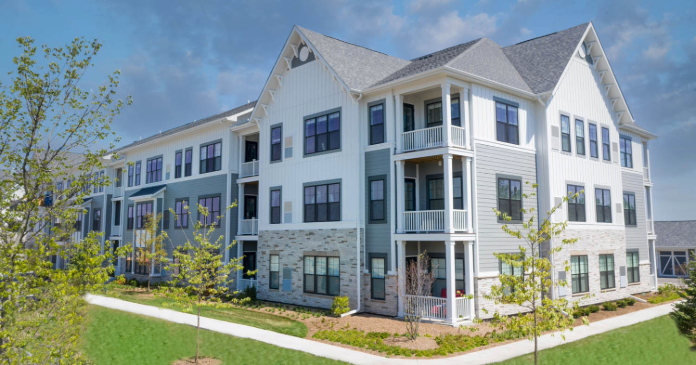Peter Drucker, the man who has been called the inventor of modern management, is credited with saying, “You can’t manage what you can’t measure.” That adage holds true in the multifamily space, where comps are crucial to informed management decisions.
Both measurements and comps are especially meaningful when it comes to utilities, which are the second or third largest operating expense at multifamily properties and arguably the largest controllable expense.
But apartment owners have been frustrated in attempts to measure their properties’ energy and utility consumption beyond the common areas. Most apartment units are individually metered for electric, with residents paying their bills directly to the utility company, and those figures aren’t readily available to owners and managers. Not knowing how much overall energy is being consumed and how it is being used makes it difficult to control, manage and plan utility strategies and track performance over time.
NWP, a provider of resident billing, utility management and financial transaction processing solutions for the multifamily housing industry, is introducing a new business intelligence analytics tool that allows owners and managers to accurately measure their properties’ utility spend, compare it against others in their own portfolio and, on an anonymous basis, against like-style properties in like geographic areas. Such benchmarking tools have been used in other industries like manufacturing and biotechnology, but are new to multifamily.
The new business intelligence and benchmarking analytics component is part of UtilitySmart—a new customizable suite of intelligent utility management products and services that includes UtilityPay Manager, UtilityTheft Recovery, CSA Monitor, Vacant Management Waste Expert, Solar, Smart Meters and Legal and Regulatory Services, Community Assessments and Tariff Rate Advisory Services.
It is a visual tool, very much like an executive dashboard, with modules that give owners and managers a way to analyze and trend their utility usage based on utility consumption and cost. The first release will include ten modules and another ten will be rolled out in the third and fourth quarter of 2010.
Once property owners achieve the transparency of their utility cost and consumption, they can do further benchmarking to provide comparison and a clear line of sight to efficiency ROI projects that help reduce energy expenditure. Then they can mix and match the available components and services of the UtilitySmart suite to create a customized utility management solution geared to meet the very specific utility management needs of their own portfolios and watch the measurable results, explains NWP Senior VP of Product Management and Engineering Jim Charles.
“We recognize, as a result of our focus groups with our customers, that managing utility spend and developing procurement strategies is crucial to effective property operations. Many times the management of utilities spells the difference between a profitable and unprofitable property operation because the utility expenses can be draconian if they are not managed correctly. The UtilitySmart suite allows owners to address five major functions; managing utility spend, benchmarking, budgeting, procurement and compliance, the newest of which is benchmarking,” said NWP president and CEO Mike Radice.
The need for UtilitySmart is underscored by the legislative mandates gaining traction across the country and the growing demand from green-conscious renters.
Green where it counts
Sustainability as a best practice is moving into the mainstream, but a pay-off for going green in the multifamily space hasn’t been quantified. In fact, to date, no determining evidence exists that proves green will entice a prospective resident to pay more rent or increase the sale value of an apartment community. “So typically, when an owner looked at green, they saw only cost and pushed back because of lack of a return on investment,” said Charles.
For the past ten years, the multifamily industry has concentrated its sustainability efforts on cost recovery, passing the cost of utilities to residents in the belief that if the residents pay for their own usage, they will use less. And passing on those utility costs, through either sub-metering or RUBS programs, has successfully improved owners’ cash flow and property cap rates.
But when the recession hit, renters, more aware of their pocketbooks and their utility costs, also began to push back. “They started to ask the question, ‘If rent is the same here as it is at this other community, then the difference is utility usage, which means my total out-of-pocket expense,'” said Charles.
Now the time is coming when apartment owners will be required to measure and disclose the energy consumption and/or cost of their properties, on an overall and per-unit basis, to potential residents, investors and lenders.
In Seattle, for instance, the owners of the 8,000 commercial and multifamily buildings with more than four units in the city will be required in 2012 to report their properties’ prior year consumption of electricity, not just common-area usage, but each residents usage, as well.
And a pilot program is underway to help city policymakers determine the initiatives they need to put in place that will assist apartment communities in achieving a 30-percent reduction in energy use by the year 2020, or suffer penalties from that point forward.
“Our very large customers, who stay up on these things are working with us. They have come to us because we work with 1,300 utility companies and have the largest source of utility invoices in our industry. We have about 2.8 million of invoices for electric, water, sewer, gas and waste and those are the five areas, when you look at the National Multi Housing Council’s studies, that you generally focus in on for the utility problem.
“Working with our customers and talking with them, we see a greater need for optimizing the utility spend in multifamily properties and assisting them to meet the upcoming mandates,” said Charles.
From recovery to optimization
NWP has heard and responded to the changing dialog around utilities that is not just about recovery anymore. “Four years ago, people would talk about utility management in terms of ‘How do I lower my late fees? How do I bill vacant recovery?’ I don’t get those questions anymore. Now the questions are, ‘We bill back to the residents as much as we can. We now need to find efficiencies to lower the overall expense. Can you help me get better at managing my utilities? Can you help me lower my consumption and my cost?'” said Mark Gentile, NWP director of product management.
While multifamily operators have improved their properties energy performance in a variety of areas over time, they haven’t necessarily benchmarked and compared those improvements against others in their portfolio or market.
“Bench-marking is really only useful when you compare it against other properties. The problem with benchmarks is they aren’t useful in a vacuum,” said Gentile.
“For instance, if your property is improving year upon year at five percent on electricity, that doesn’t necessarily mean you are doing best practices, because someone down the street may be improving at a ten percent rate. The high-quality charts on the executive dashboard of our business intelligence analytics tool allow you to see potential problems and dig in deeper to see what you need to do,” said Charles.
With its business intelligence and analytics tool, NWP currently is bench-marking for electric, gas, water, sewer and waste at 1,100 properties and plans to grow that number to 3,000 by the end of the year.
NWP’s new utility management offering includes the business intelligence and bench-marking tool to give multifamily owners transparency of cost and consumption and the clear line of sight to determine the next best steps to take to control, manage and plan utility spend and meet the coming legislative mandates.
Owners will be able to identify opportunities for efficiency projects and additional savings and, with UtilitySmart, choose the utility management services that are right for their individual portfolio.
“We want our clients to know they can be UtilitySmart clients with the business intelligence analytics tool. UtilitySmart is designed to meet the specific requirements of each unique client, but a few services will be leveraged by most, and business intelligence analytics will be one of those. It’s the road map to help identify savings opportunities,” said Gentile.
When the business intelligence and benchmarking tool is rolled out, Charles expects it will take its place alongside two other analytic products that have revolutionized the apartment industry—screening programs that use credit information to determine analytics and revenue management systems that rely on yield analytics to set rents.
NWP will introduce UtilitySmart and its business intelligence analytics tool at the National Apartment Association’s Annual Education Conference & Expo, to be held June 24-26 in New Orleans.
Author Wendy Broffman
















